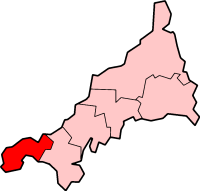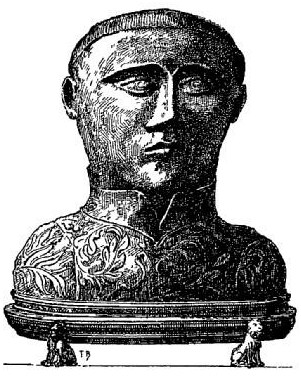Related Research Articles
Dumnonia is the Latinised name for a Brythonic kingdom that existed in Sub-Roman Britain between the late 4th and late 8th centuries CE in the more westerly parts of present-day South West England. It was centred in the area of modern Devon, but also included modern Cornwall and part of Somerset, with its eastern boundary changing over time as the gradual westward expansion of the neighbouring Anglo-Saxon kingdom of Wessex encroached on its territory. The spelling Damnonia is sometimes encountered, but that spelling is also used for the land of the Damnonii, later part of the Kingdom of Strathclyde, in present-day southern Scotland. The form Domnonia also occurs. The name of the kingdom shares a linguistic relationship with the Breton region of Domnonée.

Penwith is an area of Cornwall, England, located on the peninsula of the same name. It is also the name of a former local government district, whose council was based in Penzance. The area is named after one of the ancient administrative hundreds of Cornwall which derives from two Cornish words, penn meaning 'headland' and wydh meaning 'at the end'.
Salomon was a late 5th century Cornish 'warrior prince', possibly a King of Cornwall. His feast day takes place on the 18 October. He was the father of the Cornish bishop Saint Cybi.

Cornouaille is a historical region on the west coast of Brittany in West France. The name is cognate with Cornwall in neighbouring Great Britain. This can be explained by the settlement of Cornouaille by migrant princes from Cornwall who created an independent principality founded by Rivelen Mor Marthou, and the founding of the Bishopric of Cornouaille by ancient saints from Cornwall. Celtic Britons and the settlers in Brittany spoke a common language, which later evolved into Breton, Welsh and Cornish.

Conan Meriadoc is a legendary British Celtic leader credited with founding Brittany. Versions of his story circulated in both Brittany and Great Britain from at least the early 12th century, and supplanted earlier legends of Brittany's foundation. His story is known in two major versions, which appear in the Welsh text known as The Dream of Macsen Wledig, and in Geoffrey of Monmouth's Historia Regum Britanniae. Both texts associate him with Magnus Maximus, a Roman usurper against the Valentinianic dynasty who was widely regarded as having deprived Britain of its defences when he took its legions to claim the imperial throne. Conan's cousin or sister, Saint Elen, is said to have been Macsen Wledic's wife.
Breage or Breaca is a saint venerated in Cornwall and South West England. According to her late hagiography, she was an Irish nun of the 5th or 6th century who founded a church in Cornwall. The village and civil parish of Breage in Cornwall are named after her, and the local Breage Parish Church is dedicated to her. She is a saint in the Eastern Orthodox Church and Catholic Church.

Hayle is a port town and civil parish in west Cornwall, England, United Kingdom. It is situated at the mouth of the Hayle River and is approximately seven miles (11 km) northeast of Penzance.

King Hoel, also known as Sir Howel, Saint Hywel and Hywel the Great, was a late 5th- and early 6th-century member of the ruling dynasty of Cornouaille. He may have ruled Cornouaille jointly after the restoration of his father, Budic II of Brittany, but he seems to have predeceased his father and left his young son, Tewdwr, as Budic's heir.

Gwinear, Guigner, was a Celtic martyr, one of only two early Cornish saints whose biographies survived the Reformation. The Life of Gwinear was written in the early 14th century by a priest named Anselm, and has sometimes been printed among the works of Anselm of Canterbury. His feast day is March 23.

Bewnans Ke is a Middle Cornish play on the life of Saint Kea or Ke, who was venerated in Cornwall, Brittany and elsewhere. It was written around 1500 but survives only in an incomplete manuscript from the second half of the 16th century. The play was entirely unknown until 2000, when it was identified among the private collection of J. E. Caerwyn Williams, which had been donated to the National Library of Wales after his death the previous year. The discovery proved one of the most significant finds in the study of Cornish literature and language.

Winwaloe was the founder and first abbot of Landévennec Abbey, also known as the Monastery of Winwaloe. It was just south of Brest in Brittany, now part of France.

Ia of Cornwall was an evangelist and martyr of the 5th or 6th centuries, flourishing in the area of St Ives, Cornwall. She is said to have been an Irish princess, the sister of Erc of Slane.

Budoc of Dol was a 5th-century Breton monk and Bishop of Dol, who has been venerated since his death as a saint in both Brittany and Devon. Budoc is the patron saint of Plourin in Finistère where his relics are preserved. His feast day was originally celebrated on 8 December, the date still used in Devon, but in Brittany this has been transferred to 9 December.

Gwened, Bro-Gwened or Vannetais is a historic realm and county of Brittany in France. It is considered part of Lower Brittany.

Beunans Meriasek is a Cornish play completed in 1504. Its subject is the legends of the life of Saint Meriasek or Meriadoc, patron saint of Camborne, whose veneration was popular in Cornwall, Brittany, and elsewhere. It was written in the Cornish language, probably written around the same time and in the same place as Bewnans Ke, the only other extant Cornish play taking a saint's life as its subject.

Saint Teilo, also known by his Cornish name Eliud, was a British Christian monk, bishop, and founder of monasteries and churches. He was from Penalun (Penally) near Tenby in Pembrokeshire, south Wales.
Budic II, formerly known as Budick, was a king of Cornouaille in Brittany in the late 5th and early 6th centuries. He was father of Hoel as well as several Celtic saints.

Tetha, also known as Teath, Tecla, and by a variety of other names, was a 5th-century virgin and saint in Wales and Cornwall. She is associated with the parish church of St Teath in Cornwall. Baring-Gould gives her feast day as 27 October, but this has been called a mistaken conflation with Saint Ia. In 1878, it was held on the movable feast of Whit Tuesday. Other sources place it on 1 May, 6 September, and (mistakenly) 15 January. It is no longer observed by either the Anglican or Catholic church in Wales.

Saint Vouga was an Irish priest who moved to Brittany, now in France. He attempted to live as a hermit, but could not avoid people who came to him for cures, drawn by his reputation.
Klervi was a 5th-century pre-Congregational saint from the Welsh settlement of Ploufragan in Armorica, later a part of Brittany and France.
References
- 1 2 3 4 Ford, David Nash. "EBK: King Tewdwr Mawr of Brittany & Penwith". www.earlybritishkingdoms.com. Retrieved 22 February 2017.
- 1 2 Baring-Gould, Sabine. Lives of the British Saints: The Saints of Wales and Cornwall and Such Irish Saints as Have Dedications in Britain: "Saint Breaca". Chas. Clark (London), 1908.
- ↑ Koch, John. Celtic Culture: A Historical Encyclopedia, pp. 204 f. ABC-CLIO, 2006.